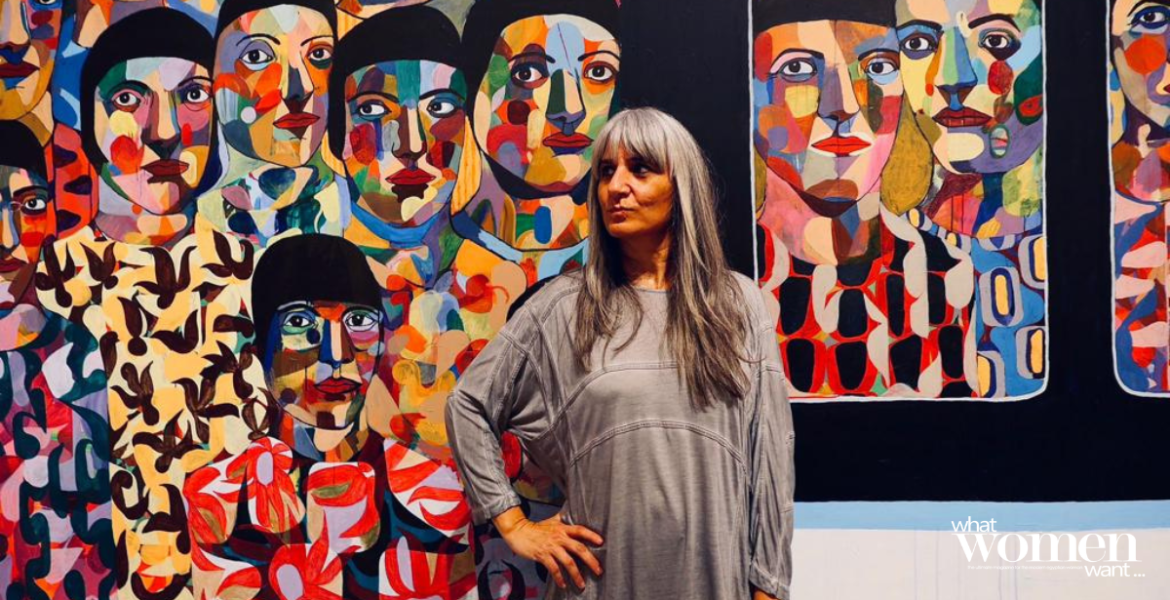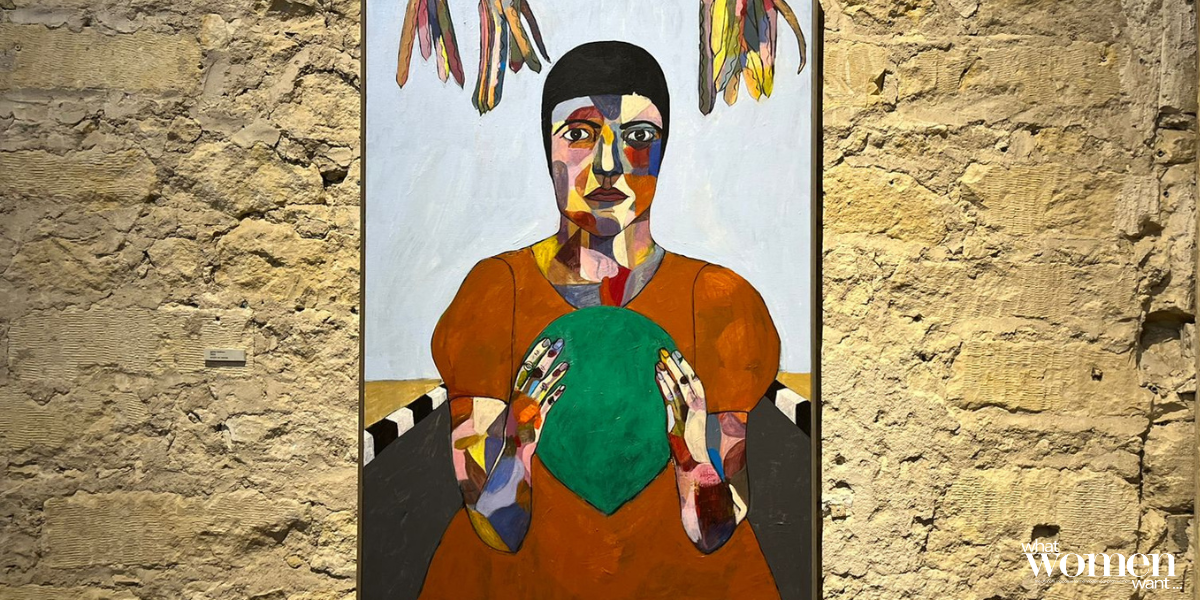The little walks around Maadi and round trips on the metro are what brought Kuwaiti artist Ghadah AlKandari’s latest collection to life. Her most recent exhibition, “Metro 23 | Half-tales From a Moving Train”, is held at Access Art Space in Downtown Cairo until December 2nd. We sat down to talk with AlKandari about her art, upbringing, and what it means to show up for Palestine as an artist.
The Gallery: “Metro 23 | Half-tales From a Moving Train”

AlKandari’s latest exhibition, “Metro 23 | Half-tales From a Moving Train”, features four rooms of mixed art. The gallery features multiple mediums of art, from portraits to framed sketches. With this exhibition, the thread that tied these different mediums was the concept of being on the metro. “The title of the show and the idea of being on the metro on a moving train as an analogy allowed me to use different mediums,” AlKandari tells us.
The first room is a bold portrayal of vulnerability, with AlKandari’s journals and sketchbooks from the past seven years. They are laid on a table in the middle of the room for the audience’s eyes.
 One of the bigger paintings in the next room is the title piece “Half Tales From a Moving Train.” Placed at the far end of the room and taking up almost an entire wall, the painting features an array of faces of different people the artist has seen on the metro. In the background are big helium balloons.
One of the bigger paintings in the next room is the title piece “Half Tales From a Moving Train.” Placed at the far end of the room and taking up almost an entire wall, the painting features an array of faces of different people the artist has seen on the metro. In the background are big helium balloons.
“The painting ‘The Green Balloon’ I was walking in Maadi, and this guy walked by, and he had a green balloon, which he gave to me. It’s so simple. It’s so poetic. But it’s life. Life is poetic.”
AlKandari speaks of how life inspires her art in simple ways. She tells us of how there is poetry in everything, “I’m just very aware of the funny things that happen, and I put them in my journal, or I put them in a painting, or I put them on a wall, and then I destroy the wall.”
The central piece of the second room is a train of paperback notebooks glued to the wall. The notebooks, lined up like the glass windows of a metro train, are each named after a station – the stops the artist takes most often. This particular installation was particularly moving. The viewer has no idea what they are about to see on the next page. It takes you by surprise. The Kuwaiti native explained, “Those journals were basically the seed for the show. It started with that idea. I had these journals, and bit-by-bit, it started to make more sense how these would represent these stations. And it started to take up these urban landscape-y look, and it plays on how the scenes change as the trains move in the metro.”
Showing up for Palestine through art: “Our fight is a cultural one”

“A Palestinian family friend once said to me ‘If we had social media during the first Nakba, I’d still be in my home.’ This was a 80-something-year-old man. He was an academic, for that to have come from him really raised my attention.”
AlKandari has been volunteering for the Palestinian Culture Center in Kuwait since 1996. Palestine has always been a part of her life. “Once they started bombing Palestine, I was going to cancel my show. But then my intentions changed. I was doing it for Palestine”, she tells us.
Art has a way of reaching people, even with the things they already know. The fight for freedom is not only physical or political. It is often also cultural and psychological. AlKandari does this by continuing her work, only this time it is in the name of Palestine. “I wanna dedicate something, even my art because it is so autobiographical. Now everything that I do, even if it has nothing to do with Palestine, is about Palestine. And everything that I sell, some of it will go to Palestine. My money, what I make, what I do, part of it will always be for Palestine.”
She reflects on her Arab identity in regards to the Palestinian cause, “We failed them. This should have been urgent from 2006 since the siege began.”
Art & Anxiety
AlKandari tells us how often, when an artist works on personal pieces, it can be hard to put them out in the world. This is especially true when it feels like such a raw, unfiltered part of the artist’s personal life. Most of the pieces in the gallery feature little pieces of personal text from the artist’s life. She tells us how to make art that is personal, you must let go a little bit when putting it into the world. A great example is the journals she put in the exhibition. The first thing you see when you walk into the room as if to set the tone for the rest of the night. “You kind of just have to let go,” she tells us “Everything is art to me because that’s how I function.”
 AlKandari narrates her journey to where she is today in an almost literary manner. After her divorce, and after her children had grown, she now had more space to explore her art form as a profession. “Your life sort of revolves around your kids when you are a mother,” she tells us. “Now that my kids had grown up, I sort of had this space to go forth and become even more myself than ever.”
AlKandari narrates her journey to where she is today in an almost literary manner. After her divorce, and after her children had grown, she now had more space to explore her art form as a profession. “Your life sort of revolves around your kids when you are a mother,” she tells us. “Now that my kids had grown up, I sort of had this space to go forth and become even more myself than ever.”
When the art goes down: “You’ll find nice pianos in Cairo”
The artist recalls her last five months in Cairo while she was still trying to figure out what was next for her. She considered moving to Tunisia. One of the most important things for her was to have a piano in her new home. “I was having dinner with a friend, and he asked why I wasn’t moving here. Just like that, a new door was unlocked in my mind. I remember he said to me, ‘You’ll find nice pianos in Cairo’, that’s why I moved here,” AlKandari tells us.
It is often the littlest things that lead us where we are going. If she hadn’t had dinner with that friend, she would’ve never bought her apartment in Cairo. If she had never bought her apartment, she would not have painted on and demolished that wall, which ended up being one of our favorite installations in the gallery. Life is funny like that. It’s poetic, but it’s life, and life is poetic.


